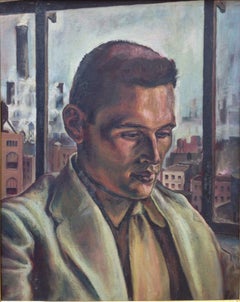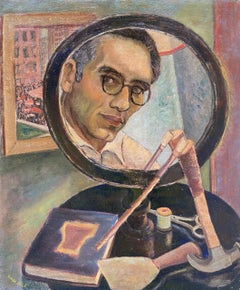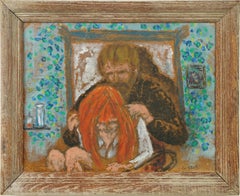Joseph Biel Art
to
1
2
Overall Width
to
Overall Height
to
2
2
2
2
2
2
1
2
2
1
1
1
2
8,780
2,809
1,654
1,312
2
1
1
Artist: Joseph Biel
"Portrait of Dr. Monroe Mufson"
By Joseph Biel
Located in Southampton, NY
Unsigned ; attributed to Joseph Biel
Good friend of Dr. Mufson
View is from New York University School
of Medicine.
Overall size with original frame 25.5 x 21 in.
Category
Mid-20th Century American Modern Joseph Biel Art
Materials
Oil, Board
$2,280 Sale Price
20% Off
Self Portrait in a Mirror with Artist's Tools, Oil on canvas, Signed, Polish
By Joseph Biel
Located in London, GB
Oil on canvas, signed bottom left
Image size: 24 x 20 inches (61 x 51 cm)
Contemporary style hand made frame
Joseph Biel
Joseph Biel was a painter and photographer who was born in ...
Category
20th Century Modern Joseph Biel Art
Materials
Canvas, Oil
Related Items
America impressionist portrait young boy 1937 Modern Figurative Oil Painting
Located in Buffalo, NY
A fantastic modern portrait of a young boy. This work is signed what appears to be Paul Sellers and dated 1937, but we have not found information on the artist.
The work dated 1936...
Category
1930s American Modern Joseph Biel Art
Materials
Oil, Board
Antique American School Signed Framed Modernist "Massage" Oil Painting
Located in Buffalo, NY
Vintage American signed interior scene oil painting. Oil on canvasboard. Signed. Framed. Image size, 14L x 11H.
Category
1950s Modern Joseph Biel Art
Materials
Canvas, Oil
$236 Sale Price
20% Off
H 13 in W 16 in D 2 in
Antique American Modernist Framed Male Portrait New England Flannel Oil Painting
Located in Buffalo, NY
Nicey painted American modernist portrait oil painting. Framed. Oil on board. Image size, 8H by 10L.
Category
1940s Modern Joseph Biel Art
Materials
Canvas, Oil
$380 Sale Price
20% Off
H 12 in W 14 in D 2 in
Rare New York City Oil Portrait by Modernist Artist Lisa Mangor, ca 1940’s
Located in Baltimore, MD
This is a highly stylized portrait of a lady by known and listed artist Lisa Mangor. Ms.Mangor was born in Russia in 1890 and came to New York likely around the beginning of World W...
Category
1940s American Modern Joseph Biel Art
Materials
Oil
$788 Sale Price
20% Off
H 28 in W 24 in D 3 in
Artist Self Portrait-Modernist Mid-Century Chicago Modernist Oil Painting.
Located in Marco Island, FL
Chicago Modernist, William Schwartz, painted this exceptional self-portrait in 1926. He studied at the Art Institute of Chicago shortly after emigrating to the United States from Ru...
Category
1920s American Modern Joseph Biel Art
Materials
Canvas, Oil
$6,000
H 24 in W 18 in D 2 in
"Don't Cry Long" Abstracted and Distorted Self-Portrait, One Crying Eye
Located in Detroit, MI
"Don't Cry Long" is a self-portrait of the artist and an unusual one at that in which the artist portrays herself shedding tears. Perhaps it is an expression of some grief experienced by Ms. Woodlock, but it also admonishes her to not "Cry Long" while at the same time poking fun because of her elongated face and the one lone "long" tear tracing a pattern down her face. In addition to self-portraits, Ethelyn painted commissioned portraits. In this painting her head is cocked and her famous bangs hang down her forehead. Compare two self-portraits, “Up From Under”, and “M’Eyes" to "Don't Cry Long." The major differences are the close facial view and the brilliant blood red paint that fills the entire canvas.
This painting is included in the book, "Dreams Have Wings: An Artist's Journey into Magic and Mystery" printed in the United States, 1985. She describes "Don't Cry Long" as showing how funny looking we are, if we cry too long.
Ethelyn Woodlock...
Category
Mid-20th Century American Modern Joseph Biel Art
Materials
Oil, Masonite
Early Modern American Portrait, Pennsylvania/Massachusetts, Frank Anderson Trapp
Located in Baltimore, MD
This is a very stylized and powerful portrait by the noted artist Frank Anderson Trapp. It is dated 1940, and is very much in the modern style of French painters Ferdinand Leger...
Category
1940s American Modern Joseph Biel Art
Materials
Oil
$2,650
H 25 in W 20 in D 2 in
1930s Painting of a Pensive Young Woman, Titled, "Green Scarf" by Francis Chapin
By Francis Chapin
Located in Chicago, IL
A 1930s oil on board painting of a pensive young woman, titled, "Green Scarf" by artist Francis Chapin. Painting is in a dark, painted wood frame. Image size: 14 1/4" x 10". Fram...
Category
1930s American Modern Joseph Biel Art
Materials
Oil, Board
Original Arthur Smith Modernist Erotic Painting
By Arthur Smith
Located in New York, NY
Arthur Smith (American, 1897-1972)
Untitled, 20th century
Oil on board
8 x 9 7/8 in.
Framed: 14 1/4 x 16 3/8 in.
Signed lower left: A Smith
Arthur Smith is a listed American paint...
Category
20th Century American Modern Joseph Biel Art
Materials
Board, Oil
Otto Hake Signed American Modernist Woman Portrait Framed Original Oil Painting
Located in Buffalo, NY
Nice modernist portrait for sale here. Oil on board. Signed. Nicely framed. Image size, 9L x 10H.
Category
1920s Modern Joseph Biel Art
Materials
Canvas, Oil
$716 Sale Price
20% Off
H 15 in W 14 in D 2 in
Simka Simkhovitch WPA Artist Oil Painting Family Mother, Kids American Modernist
By Simka Simkhovitch
Located in Surfside, FL
Simka Simkhovitch (Russian/American 1893 - 1949)
This came with a small grouping from the artist's family, some were hand signed some were not.
These were studies for larger paintings.
Simka Simkhovitch (Симха Файбусович Симхович) (aka Simka Faibusovich Simkhovich) (Novozybkov, Russia May 21, 1885 O.S./June 2, 1885 N.S.—Greenwich, Connecticut February 25, 1949) was a Ukrainian-Russian Jewish artist and immigrant to the United States. He painted theater scenery in his early career and then had several showings in galleries in New York City. Winning Works Progress Administration (WPA) commissions in the 1930s, he completed murals for the post offices in Jackson, Mississippi and Beaufort, North Carolina. His works are in the permanent collections of the Dallas Museum of Art, the National Museum of American Art and the Whitney Museum of American Art. Born outside Kyiv (Petrograd Ukraine) into a Jewish family who owned a small department store. During a severe case of measles when he was seven, Simcha Simchovitch sketched the views outside his window and decided to become an artist, over his father's objections. Beginning in 1905, he studied at the Grekov Odessa Art School and upon completion of his studies in 1911 received a recommendation to be admitted to the Imperial Academy of Arts. Though he enrolled to begin classes in architecture, painting, and sculpture at the Imperial Academy, he was dropped from the school roster in December because of the quota on the number of Jewish students and drafted into the army. Simchovitch served as a private in the 175th Infantry Regiment Baturyn [ru] until his demobilization in 1912. Re-enrolling in the Imperial Academy, he audited classes.
Simka Simkhovitch exhibited paintings and sculptures in 1918 as part of an exhibition of Jewish artists and in 1919 placed 1st in the competition "The Great Russian Revolution" with a painting called "Russian Revolution" which was hung in the State Museum of Revolution. In 1922, Simkha Simkhovitch exhibited at the International Book Fair in Florence (Italian: Fiera Internazionale del Libro di Firenze). In 1924, Simkhovitch came to the United States to make illustrations for Soviet textbooks and decided to immigrate instead. Initially he supported himself by doing commercial art and a few portrait commissions. In 1927, he was hired to paint a screen for a scene in the play "The Command to Love" by Fritz Gottwald and Rudolph Lothar which was playing at the Longacre Theatre on Broadway. Art dealers began clamoring for the screen and Simkhovitch began a career as a screen painter for the theater. Catching the attention of the screenwriter, Ernest Pascal, he worked as an illustrator for Pascal, who then introduced him to gallery owner, Marie Sterner. Simkhovitch's works appeared at the Marie Sterner Gallery beginning with a 1927 exhibit and were repeated the following year. Simkhovitch had an exhibit in 1929 at Sterner's on circus paintings. In 1931, he held a showing of works at the Helen Hackett Gallery, in New York City and later that same year he was one of the featured artists of a special exhibit in San Francisco at the California Palace of the Legion of Honor in Lincoln Park. The exhibit was coordinated by Marie Sterner and included four watercolors, including one titled "Nudes". He is of the generation of Russian Soviet artists such as Isaac Pailes, Serge Charchoune, Marc Chagall, Chana Orloff, Isaac Ilyich Levitan, and Ossip Zadkine.
In 1936, Simkhovitch was selected to complete the mural for the WPA Post office project in Jackson, Mississippi. The mural was hung in the post office and courthouse in 1938 depicted a plantation theme. Painted on the wall behind the judge’s bench, “Pursuits of Life in Mississippi”, a depiction of black workers engaged in manual labor amid scenes of white professionals and socialites, was eventually covered over in later years during renovations due to its stereotypical African American imagery. The following year, his painting "Holiday" won praise at an exhibition in Lincoln, Nebraska. In 1940, Simkhovitch's second WPA post office project was completed when four murals, "The Cape Lookout Lighthouse and the Orville W. Mail Boat", "The Wreck of the Crissie Wright", "Sand Ponies" and "Canada Geese" were installed in Beaufort, North Carolina. The works were commissioned in 1938 and did not generate the controversy that the Jackson mural had. The main mural is "The Wreck of the Crissie Wright" and depicts a shipwreck which had occurred in Beaufort in 1866. "The Cape Lookout Lighthouse and the Orville W. Mail Boat" depicted the lighthouse built in 1859 and the mail boat that was running mail during the time which Simkhovitch was there. The boat ran mail for the area until 1957. "Sand Ponies" shows the wild horses common to the North Carolina barrier islands and "Canada Geese" showed the importance of hunting and fishing in the area. All four murals were restored in the 1990s by Elisabeth Speight, daughter of two other WPA muralists, Francis Speight...
Category
1930s American Modern Joseph Biel Art
Materials
Oil, Board
Antique American Modernist Framed Flower Girl Portrait Signed Oil Painting
Located in Buffalo, NY
Modernist portrait and landscape oil painting. Framed. Oil on canvas. Signed. Image size, 18H by 14L.
Category
1960s Modern Joseph Biel Art
Materials
Canvas, Oil
$300 Sale Price
20% Off
H 24 in W 20 in D 2 in
Joseph Biel art for sale on 1stDibs.
Find a wide variety of authentic Joseph Biel art available for sale on 1stDibs. You can also browse by medium to find art by Joseph Biel in board, oil paint, paint and more. Much of the original work by this artist or collective was created during the 20th century and is mostly associated with the modern style. Not every interior allows for large Joseph Biel art, so small editions measuring 16 inches across are available. Customers who are interested in this artist might also find the work of William Harnden, Francis Chapin, and Virginia Dehn. Joseph Biel art prices can differ depending upon medium, time period and other attributes. On 1stDibs, the price for these items starts at $2,850 and tops out at $2,850, while the average work can sell for $2,850.


